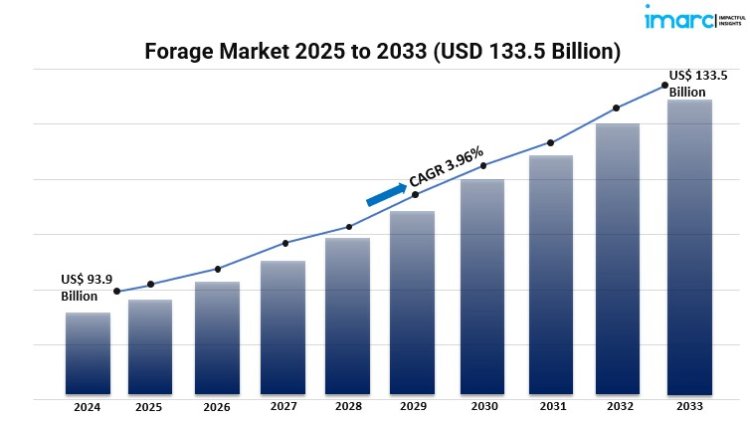What Impact Are Technological Innovations Having on Forage Production Efficiency?
The forage market is valued at USD 93.9 billion in 2024 and is expected to reach USD 133.5 billion by 2033, growing at a 3.96% CAGR.

What is the Current Outlook of the Forage Market?
The global forage market is experiencing steady growth, driven by increased demand for dairy and meat products. As populations rise and the consumption of animal-based goods escalates, the need for high-quality forage has surged. The market, valued at USD 93.9 billion in 2024, is projected to reach USD 133.5 billion by 2033, with a CAGR of 3.96%. Factors like population growth, sustainable farming practices, and advancements in technology are all contributing to this upward trajectory.
Study Assumption Years:
- Base Year: 2024
- Historical Year: 2019-2024
- Forecast Year: 2025-2033
Forage Market Key Takeaways:
- The forage market is valued at USD 93.9 billion in 2024 and is expected to reach USD 133.5 billion by 2033, growing at a 3.96% CAGR.
- Growing demand for dairy and meat products is driving market expansion.
- Technological innovations, including precision agriculture, are boosting production efficiency.
- Organic and sustainable farming methods are gaining popularity.
- North America and Europe are major exporters of high-quality forage, while Asia-Pacific is witnessing rapid growth.
- The development of drought-resistant crops and water-efficient techniques presents growth opportunities.
- Price volatility due to climate changes remains a challenge but opens avenues for innovation.
What Are the Key Drivers for Growth in the Forage Market?
Demand for Animal Products
As the world’s population keeps increasing and nations develop economically, the need for animal products like meat and dairy is on the rise. Forage is essential for livestock well-being. This directly affects the quantity and quality of meat and dairy produced. Thus, higher demand leads to more forage needed.
Technological Advancements
New tech in farming is boosting forage creation a lot. Tools like smart farming, crop-monitoring drones, and genetically modified organisms are playing a big role. These advancements not only heighten crop quality but also lessen water use and ramp up yields. With smart farming tools, costs can drop too.
Sustainability and Organic Farming
People are becoming more aware of environmental challenges. They’re also recognizing the perks of organic farming. This is steering the forage market toward eco-friendly practices. Organic feed is becoming more popular as people seek safer, natural options for their livestock. Thus, this type of forage is gaining traction in global circles.
Market Segmentation:
- By Crop Type:
- Cereals: Includes crops like wheat and barley used for forage production.
- Legumes: Includes crops like clover and alfalfa, which are high in protein.
- Grasses: Includes crops like ryegrass and fescue, which are common forage types for livestock.
- By Product Type:
- Stored Forage: Includes dried, baled, or ensiled forage stored for long-term use.
- Fresh Forage: Refers to forage crops harvested and used immediately without preservation.
- By Animal Type:
- Ruminants: Includes cattle, sheep, and goats, which are major consumers of forage.
- Swine: Forage used for pigs, which typically require a balanced diet.
- Poultry: Forage used for birds like chickens, ducks, and turkeys.
- Others: Includes forage used for other animals like horses or rabbits.
- Breakup by Region:
- North America (United States, Canada)
- Asia Pacific (China, Japan, India, South Korea, Australia, Indonesia, Others)
- Europe (Germany, France, United Kingdom, Italy, Spain, Russia, Others)
- Latin America (Brazil, Mexico, Others)
- Middle East and Africa
What Are the Regional Trends in the Forage Market?
North America and Europe are key players in the forage realm, thanks to their mature farming sectors and high-quality forage systems. These areas lead in adopting new technologies, which helps them keep the top spot in forage exports. Meanwhile, the Asia-Pacific region is on the rise, driven by the need for better animal feed, supported by local appetites and exports to the West.
What Are the Recent Developments in the Forage Market?
The forage market is leaning towards organic farming and sustainability. As worries ramp up about the harm traditional farming does to nature, there’s a noticeable shift towards organic forage production. This trend is in sync with the growing popularity of organic foods, which is expected to keep rising. Plus, innovations, including drones and satellites, are making forage production quicker and more precise, helping to raise yield while minimizing harm to the environment.
Who Are the Key Players in the Forage Market?
- Allied Seed LLC
- Barenbrug USA
- BrettYoung
- Cargill Incorporated
- Corteva Inc.
- DLF Seeds A/S
- Forage Genetics International LLC (Land O'Lakes Inc.)
- King's Agriseeds Inc.
- Rivard's Turf & Forage
- Standlee Premium Products LLC
If you require any specific information that is not covered currently within the scope of the report, we will provide the same as a part of the customization.
About Us:
IMARC Group is a global management consulting firm that helps the world’s most changemakers to create a lasting ambitious impact. The company provides a comprehensive suite of market entry and expansion services. IMARC offerings include thorough market assessment, considerations studies, company incorporation assistance, factory setup support, regulatory approvals and licensing navigation, branding, marketing and sales strategies, competitive landscape and benchmarking analyses, pricing and cost research, and procurement research.
What's Your Reaction?
















.jpg)
.jpg)

